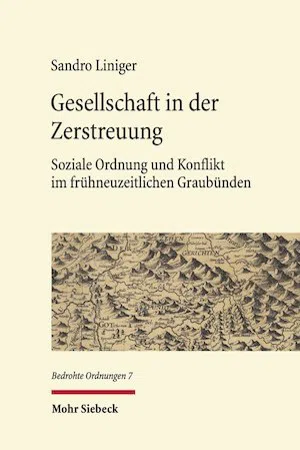
Gesellschaft in der Zerstreuung : Soziale Ordnung und Konflikt im frühneuzeitlichen Graubünden
- English
- PDF
- Available on iOS & Android
Gesellschaft in der Zerstreuung : Soziale Ordnung und Konflikt im frühneuzeitlichen Graubünden
About this book
Despite established social, political and cultural differences, and despite the tricky mountainous setting, over 50 early modern era alpine valley communities managed to cooperate reliably with one another without either central instance or state. Notwithstanding these adverse conditions – such as steep mountains, remote valleys and settlements strewn far apart – they were able to successfully organise their common social and political interests. They even developed a dynamic unity and order completely without superior central power. This at first seemingly paradoxical finding is taken by Sandro Liniger as an opportunity to analyse just how such a dispersed society functions: Which specific logic characterises such an alternative form of organising common social and political life? Which instabilities and resistances are peculiar to it? And which conflicts characterise it?
Frequently asked questions
- Essential is ideal for learners and professionals who enjoy exploring a wide range of subjects. Access the Essential Library with 800,000+ trusted titles and best-sellers across business, personal growth, and the humanities. Includes unlimited reading time and Standard Read Aloud voice.
- Complete: Perfect for advanced learners and researchers needing full, unrestricted access. Unlock 1.4M+ books across hundreds of subjects, including academic and specialized titles. The Complete Plan also includes advanced features like Premium Read Aloud and Research Assistant.
Please note we cannot support devices running on iOS 13 and Android 7 or earlier. Learn more about using the app.
Information
Table of contents
- Cover
- Vorwort
- Inhaltsverzeichnis
- I. Einleitung: Gesellschaft in der Zerstreuung
- II. Alpine Sozialformen
- III. Landammänner, Gouverneure, Patrone: Figuren politischer Macht
- IV. Kollektive Abwehrmechanismen: „Fähnlilupf“ und „Strafgericht“ 1550–1620
- V. 1618–1621: Herrschaft der Propheten
- VI. Schluss
- VII. Literatur- und Quellenverzeichnis
- Register